You are using an out of date browser. It may not display this or other websites correctly.
You should upgrade or use an alternative browser.
You should upgrade or use an alternative browser.
The Lost Breyfogle Gold Mine
- Thread starter Oroblanco
- Start date
Oroblanco
Gold Member
- Joined
- Jan 21, 2005
- Messages
- 7,841
- Reaction score
- 9,876
- Golden Thread
- 0
- Location
- DAKOTA TERRITORY
- Detector(s) used
- Tesoro Lobo Supertraq, (95%) Garrett Scorpion (5%)
- #102
Thread Owner
Still another version
Not to try the patience of you all, just to present another version of this tale:

Personally I suspect this was adjusting the tale to 'shoe fit' and convince investors that the Royal Flush mine was indeed the lost Breyfogle mine. However, the fact that so many good to excellent mines were discovered by treasure hunters and prospectors out hunting for the Breyfogle is evidence that going out searching just might pay off for you. You can't find any gold sitting on the couch at home watching TV after all.
Back to coffee for me, there is so much more to this tale!




Not to try the patience of you all, just to present another version of this tale:

Personally I suspect this was adjusting the tale to 'shoe fit' and convince investors that the Royal Flush mine was indeed the lost Breyfogle mine. However, the fact that so many good to excellent mines were discovered by treasure hunters and prospectors out hunting for the Breyfogle is evidence that going out searching just might pay off for you. You can't find any gold sitting on the couch at home watching TV after all.
Back to coffee for me, there is so much more to this tale!




Oroblanco
Gold Member
- Joined
- Jan 21, 2005
- Messages
- 7,841
- Reaction score
- 9,876
- Golden Thread
- 0
- Location
- DAKOTA TERRITORY
- Detector(s) used
- Tesoro Lobo Supertraq, (95%) Garrett Scorpion (5%)
- #103
Thread Owner
Another location where the Breyfogle is found again!

I wonder just how many times the lost Breyfogle was "found"? It is starting to rival the Lost Dutchman for both different versions of the tale and for the many times it was "found"!
Sock coffee anyone?





I wonder just how many times the lost Breyfogle was "found"? It is starting to rival the Lost Dutchman for both different versions of the tale and for the many times it was "found"!
Sock coffee anyone?




KANACKI
Bronze Member
- Joined
- Mar 1, 2015
- Messages
- 1,445
- Reaction score
- 5,940
- Golden Thread
- 0
- Primary Interest:
- All Treasure Hunting
Hello Oro
Yes indeed the story is a classic example how such stories take on a life of their own. Same with Dutchman story as well as Beale , Oak island, Cocos island and many others. The truth gets buried beneath a whole encyclopedia of lore gets added to story to point everyone gets lost in a bewildering array of versions of he said this and she said that.
Perhaps that is what attracts us to such stories the urge to untangle the mess of intertwining stories wrapped around themselves?
Coffee? or perhaps some thing a little stronger? Purely medicinal of course!

Kanacki
Yes indeed the story is a classic example how such stories take on a life of their own. Same with Dutchman story as well as Beale , Oak island, Cocos island and many others. The truth gets buried beneath a whole encyclopedia of lore gets added to story to point everyone gets lost in a bewildering array of versions of he said this and she said that.
Perhaps that is what attracts us to such stories the urge to untangle the mess of intertwining stories wrapped around themselves?
Coffee? or perhaps some thing a little stronger? Purely medicinal of course!


Kanacki
Last edited:
Oroblanco
Gold Member
- Joined
- Jan 21, 2005
- Messages
- 7,841
- Reaction score
- 9,876
- Golden Thread
- 0
- Location
- DAKOTA TERRITORY
- Detector(s) used
- Tesoro Lobo Supertraq, (95%) Garrett Scorpion (5%)
- #105
Thread Owner
One more newspaper article, this one has an interesting version of the tale and pins the location differently from many others. I will attach it as a PDF so those whom are not interested in more newspaper articles can easily skip it.
Here is a map of the area being referred to in the article;
https://www.google.com/maps/place/Coyote+Hole,+NV/@37.753733,-117.854814,83669m/data=!3m1!1e3!4m5!3m4!1s0x80be824a283b1143:0x487f6b4c842b544a!8m2!3d37.7971525!4d-117.8053757?hl=en
It is surprising how many different mines (and un-named finds) were being claimed to be the lost Breyfogle, similar to the way the lost Dutchman is regularly claimed as found these days. The big difference being that when they were claiming to have found the Breyfogle, they had found gold and showed it - unlike today with our many different claimants for the LDM.
As Kanacki said, it is a challenge to try to sort out the many different versions to try to get at the truth. I have noticed some common points like the 15 miles from Death Valley, which would include a vast area of country even so, but why is this detail so frequently repeated? It appears that it a key clue that probably did originate with Breyfogle. As to WHICH Breyfogle, that is quite another issue!
I might need something stronger than coffee this time too!




Here is a map of the area being referred to in the article;
https://www.google.com/maps/place/Coyote+Hole,+NV/@37.753733,-117.854814,83669m/data=!3m1!1e3!4m5!3m4!1s0x80be824a283b1143:0x487f6b4c842b544a!8m2!3d37.7971525!4d-117.8053757?hl=en
It is surprising how many different mines (and un-named finds) were being claimed to be the lost Breyfogle, similar to the way the lost Dutchman is regularly claimed as found these days. The big difference being that when they were claiming to have found the Breyfogle, they had found gold and showed it - unlike today with our many different claimants for the LDM.
As Kanacki said, it is a challenge to try to sort out the many different versions to try to get at the truth. I have noticed some common points like the 15 miles from Death Valley, which would include a vast area of country even so, but why is this detail so frequently repeated? It appears that it a key clue that probably did originate with Breyfogle. As to WHICH Breyfogle, that is quite another issue!
I might need something stronger than coffee this time too!




Attachments
Last edited:
KANACKI
Bronze Member
- Joined
- Mar 1, 2015
- Messages
- 1,445
- Reaction score
- 5,940
- Golden Thread
- 0
- Primary Interest:
- All Treasure Hunting
Hello Oro
I do not know for sure if you might of met Hardluck or talked to him on another forum? He had a reasonable solution to such treasure stories is to search for the earliest account is more likely an more accurate version of such stories. His analogy of such stories the later stories are like branches growing off the original stump and take on a life of thier own.
Coffee?
Kanacki
I do not know for sure if you might of met Hardluck or talked to him on another forum? He had a reasonable solution to such treasure stories is to search for the earliest account is more likely an more accurate version of such stories. His analogy of such stories the later stories are like branches growing off the original stump and take on a life of thier own.
Coffee?

Kanacki
aw11mr2
Full Member
- Joined
- May 14, 2015
- Messages
- 105
- Reaction score
- 141
- Golden Thread
- 0
- Primary Interest:
- All Treasure Hunting
I have some Death Valley related books that might be of interest.
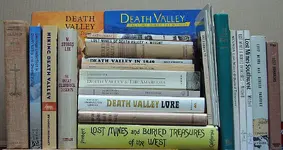
Lost Mines of Death Valley
Harold O. Weight
Copyright 1970 3rd edition
Twentynine Palms: The Calico Press
Soft cover, 86 pages
LOC 70-125556
5.5 x 8.5 inches
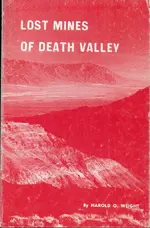
Mr. Wright includes most of the (conflicting) lost Breyfogle lode stories. The author notes that numerous books and magazine articles
mis-identified Charles C. Breyfogle, the discoverer, as Jacob, Louis, James, John, Herman or Anton. Mr. Wright (and Mr. Lingenfelter in his book below)
clearly established it was Charles C. Breyfogle. According to the author, “A Jacob Breyfogle (Charles Breyfogle’s cousin) appeared in
Pioche, Nevada, in the early 1870s, with a crude map of the ledge’s location. He made several searches for the gold from Pioche to
the Funeral Mountains. Since then most Breyfogle hunters and modern retellers of the legend have considered Jacob the original discoverer.”
There doesn’t seem to be many recorded statements by Breyfogle. The author provides the basic clues:
1. Breyfogle said that the ledge was in Death Valley. Breyfogle concentrated his later searches in the Funeral Mountains.
2. Breyfogle said that outcrop was on a reddish hillside.
3. Breyfogle said that the outcrop was within sight of a green mesquite tree.
4. Several of the stories mention Coyote Holes. According to the author: “Salt Springs, on a fork of the underground Amargosa River
near the southeastern end of the great Death Valley trough also has been called Coyote Holes.”
There are several stories about the gold-laden ore that Breyfogle displayed.
1. Breyfogle allegedly left a specimen of ore (said to contain 18 ounces of gold) with his cousin, William O. Breyfogle of San Francisco.
2. Breyfogle supposedly gave a piece to the people that tended him after he was found injured at Stump Spring.
3. A bank in Austin, NV was reported to have a specimen of Breyfogle’s ore on display. The author tried to track down this specimen
but could not locate it.
4. One story says Breyfogle was given the piece of ore by one of the two men that were traveling from Virginia City, NV to Texas
to join the Confederacy.
5. One story speculates that he picked up the piece of ore when he temporarily lived in Virginia City, NV.
6. One story says that some forty-niners on the way to the California gold field gave Breyfogle the specimen and told him they found it
in the Death Valley area.
7. Others speculate that prospectors looking for a grubstake might have shown rich specimens they claimed came from the Breyfogle lode
to solicit a grubstake.
What was known about the specimen? Mr. Wright compiled the different descriptions:
“Herman Jones said the ore was reddish-brown quartz, decomposed on one side, over half gold. Frank Denning described it as a distinctive
rose-pink free milling quartz with occasional brownish spots. Bourke Lee said it was a dirty brown quartz. Philip Johnson affirmed it
as blood-red quartz, with gold the size of wheat grains. George A. Smith says it was a rich yellow carbonate. John D. Mitchell detailed it once
as pale yellow carbonate full of black silver sulphides, horn silver and gold. In a later version he changed it to an outcropping of pink quartz.
Bob Montgomery says it was brown. Henry McNamara says red; Neill C. Wilson, greyish. J. Frank Dobie has the float soft greyish-white, and
the ledge pinkish feldspar. Jacob Gooding said he knew Breyfogle and saw his ore. Gooding was an assayer. He told Stoddard many times
the ore was very reddish, apparently impregnated with iron. Not quartz, but silicified — a sort of porphyry.”
Death Valley & The Amargosa: A Land of Illusion
Richard E. Lingenfelter
Copyright 1986
Berkeley: University of California Press
Soft cover, viii + 664 pages
ISBN 0-520-06356-2
6.0 x 9.0 inches
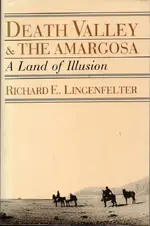
Breyfogle is discussed in “Alvord and Breyfogle,” pages 69 — 79.
The author does the best job unraveling one of the stories and reconciling the events of the multiple trips that Breyfogle took to find the lost lode.
Breyfogle seems to have made over 6 trips between the discovery in early 1983 to the fall or winter of 1868.
The chapter and bibliography for the chapter (pp. 490 — 492) can be found online. Portions of the book is available for viewing at books.google.com.
The bibliography can be seen by searching for “Sterling M. Holdredge 1865.”
Lost Mines and Buried Treasures of the West: Bibliography and Place Names — from Kansas West to California, Oregon, Washington, and Mexico
Thomas Probert
Copyright 1977
Berkeley: University of California Press
Hard cover. xviii +593 pages
ISBN 0-520-03327-2
7.7 x 10.25 inches
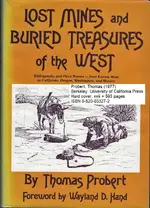
This is a reference book with a bibliography of books, magazines, and newspaper articles containing stories about the Lost Breyfogle (up until 1977).
The section on the Lost Breyfogle Mine are on pages 198 — 111.
Death Valley Prospectors
Dane Coolidge
Morongo Valley, CA: Sagebrush Press
Copyright 1937, Reprint copyright 1985
Soft cover, 128 pages
ISBN 0-930704-17-7 (Trade Edition)
6.0 x 9.0 inches
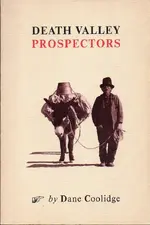
Chapter 6 is on the The Lost Breyfogle Mine (pp. 45 — 53).
The author says that Breyfogle was named Louis Jacob Breyfogle. The author interviewed several people that were allegedly a friend or
acquaintance of Breyfogle. I chuckled when I read the author’s statement: “The only way to know anything about these mining discoveries
is to go to just one man. If you go to two, what you know is reduced by half. Go to three and you don’t know anything.”
Two of the various stories in the book:
1. From Smitty, a burro-man from Rhyolite. Two partners were killed and Breyfogle taken prisoner by Indians, likely in the Panamint Mtn.
He escaped, headed east, found the ore, and reached “Daylight Spring.” Lost lode is assumed to be in the Funeral Mountains.
2. Statement of Herman Jones, of Shoshone, CA. He got his info from Old Man Finley, who was a member of the original party of ten which
took Breyfogle back to Death Valley, after he recovered from his long illness in Austin (NV). Breyfogle found ore somewhere between
Furnace Creek and Stump Spring. “He couldn’t tell where he found it, but in his saner moments he kept repeating that it was near a place
where two canyons came together, forming a spring where there was one big mesquite tree.” Finley believes the location is near
Sheep Head Spring (west-southwest of Shoshone), on the east side of Death Valley. In this story, Breyfogle was hit on the head at Stump Spring.

Lost Mines of Death Valley
Harold O. Weight
Copyright 1970 3rd edition
Twentynine Palms: The Calico Press
Soft cover, 86 pages
LOC 70-125556
5.5 x 8.5 inches

Mr. Wright includes most of the (conflicting) lost Breyfogle lode stories. The author notes that numerous books and magazine articles
mis-identified Charles C. Breyfogle, the discoverer, as Jacob, Louis, James, John, Herman or Anton. Mr. Wright (and Mr. Lingenfelter in his book below)
clearly established it was Charles C. Breyfogle. According to the author, “A Jacob Breyfogle (Charles Breyfogle’s cousin) appeared in
Pioche, Nevada, in the early 1870s, with a crude map of the ledge’s location. He made several searches for the gold from Pioche to
the Funeral Mountains. Since then most Breyfogle hunters and modern retellers of the legend have considered Jacob the original discoverer.”
There doesn’t seem to be many recorded statements by Breyfogle. The author provides the basic clues:
1. Breyfogle said that the ledge was in Death Valley. Breyfogle concentrated his later searches in the Funeral Mountains.
2. Breyfogle said that outcrop was on a reddish hillside.
3. Breyfogle said that the outcrop was within sight of a green mesquite tree.
4. Several of the stories mention Coyote Holes. According to the author: “Salt Springs, on a fork of the underground Amargosa River
near the southeastern end of the great Death Valley trough also has been called Coyote Holes.”
There are several stories about the gold-laden ore that Breyfogle displayed.
1. Breyfogle allegedly left a specimen of ore (said to contain 18 ounces of gold) with his cousin, William O. Breyfogle of San Francisco.
2. Breyfogle supposedly gave a piece to the people that tended him after he was found injured at Stump Spring.
3. A bank in Austin, NV was reported to have a specimen of Breyfogle’s ore on display. The author tried to track down this specimen
but could not locate it.
4. One story says Breyfogle was given the piece of ore by one of the two men that were traveling from Virginia City, NV to Texas
to join the Confederacy.
5. One story speculates that he picked up the piece of ore when he temporarily lived in Virginia City, NV.
6. One story says that some forty-niners on the way to the California gold field gave Breyfogle the specimen and told him they found it
in the Death Valley area.
7. Others speculate that prospectors looking for a grubstake might have shown rich specimens they claimed came from the Breyfogle lode
to solicit a grubstake.
What was known about the specimen? Mr. Wright compiled the different descriptions:
“Herman Jones said the ore was reddish-brown quartz, decomposed on one side, over half gold. Frank Denning described it as a distinctive
rose-pink free milling quartz with occasional brownish spots. Bourke Lee said it was a dirty brown quartz. Philip Johnson affirmed it
as blood-red quartz, with gold the size of wheat grains. George A. Smith says it was a rich yellow carbonate. John D. Mitchell detailed it once
as pale yellow carbonate full of black silver sulphides, horn silver and gold. In a later version he changed it to an outcropping of pink quartz.
Bob Montgomery says it was brown. Henry McNamara says red; Neill C. Wilson, greyish. J. Frank Dobie has the float soft greyish-white, and
the ledge pinkish feldspar. Jacob Gooding said he knew Breyfogle and saw his ore. Gooding was an assayer. He told Stoddard many times
the ore was very reddish, apparently impregnated with iron. Not quartz, but silicified — a sort of porphyry.”
Death Valley & The Amargosa: A Land of Illusion
Richard E. Lingenfelter
Copyright 1986
Berkeley: University of California Press
Soft cover, viii + 664 pages
ISBN 0-520-06356-2
6.0 x 9.0 inches

Breyfogle is discussed in “Alvord and Breyfogle,” pages 69 — 79.
The author does the best job unraveling one of the stories and reconciling the events of the multiple trips that Breyfogle took to find the lost lode.
Breyfogle seems to have made over 6 trips between the discovery in early 1983 to the fall or winter of 1868.
The chapter and bibliography for the chapter (pp. 490 — 492) can be found online. Portions of the book is available for viewing at books.google.com.
The bibliography can be seen by searching for “Sterling M. Holdredge 1865.”
Lost Mines and Buried Treasures of the West: Bibliography and Place Names — from Kansas West to California, Oregon, Washington, and Mexico
Thomas Probert
Copyright 1977
Berkeley: University of California Press
Hard cover. xviii +593 pages
ISBN 0-520-03327-2
7.7 x 10.25 inches

This is a reference book with a bibliography of books, magazines, and newspaper articles containing stories about the Lost Breyfogle (up until 1977).
The section on the Lost Breyfogle Mine are on pages 198 — 111.
Death Valley Prospectors
Dane Coolidge
Morongo Valley, CA: Sagebrush Press
Copyright 1937, Reprint copyright 1985
Soft cover, 128 pages
ISBN 0-930704-17-7 (Trade Edition)
6.0 x 9.0 inches

Chapter 6 is on the The Lost Breyfogle Mine (pp. 45 — 53).
The author says that Breyfogle was named Louis Jacob Breyfogle. The author interviewed several people that were allegedly a friend or
acquaintance of Breyfogle. I chuckled when I read the author’s statement: “The only way to know anything about these mining discoveries
is to go to just one man. If you go to two, what you know is reduced by half. Go to three and you don’t know anything.”
Two of the various stories in the book:
1. From Smitty, a burro-man from Rhyolite. Two partners were killed and Breyfogle taken prisoner by Indians, likely in the Panamint Mtn.
He escaped, headed east, found the ore, and reached “Daylight Spring.” Lost lode is assumed to be in the Funeral Mountains.
2. Statement of Herman Jones, of Shoshone, CA. He got his info from Old Man Finley, who was a member of the original party of ten which
took Breyfogle back to Death Valley, after he recovered from his long illness in Austin (NV). Breyfogle found ore somewhere between
Furnace Creek and Stump Spring. “He couldn’t tell where he found it, but in his saner moments he kept repeating that it was near a place
where two canyons came together, forming a spring where there was one big mesquite tree.” Finley believes the location is near
Sheep Head Spring (west-southwest of Shoshone), on the east side of Death Valley. In this story, Breyfogle was hit on the head at Stump Spring.
Last edited:
aw11mr2
Full Member
- Joined
- May 14, 2015
- Messages
- 105
- Reaction score
- 141
- Golden Thread
- 0
- Primary Interest:
- All Treasure Hunting
Breyfogle Regional Points of Interest
Note: One of the stories has Breyfogle escaping attack at Salt Spring or Resting Spring and
Traveling through Death Valley, finding the lode, and later found delirious near
Round Mountain, NV. That’s over 200 miles as the crow flies.
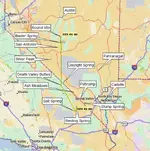
Breyfogle Points of Interest within and near, Death Valley
Note: The small dashed lines near the bottom of the map shows the trace of the Old Spanish Trail. Stump Spring, Resting Spring,
and Salt Spring are watering holes along the Old Spanish Trail. According to Harold O. Weight, Resting Spring was also known as Coyote Holes.
Note: Death Valley Buttes was also known as Breyfogle Buttes
Note: I believe the Furnace Creek referred to in the narratives is located near the headwater of Furnace Creek. Not the Furnace Creek that is presently
located in the valley of Death Valley.
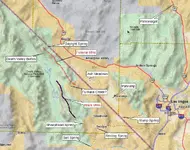
The Keane Wonder mine and Chloride Cliff mine were rarely considered the origin of the Breyfogle discovery although the mines are located
in the Funeral Mountains, within the area Breyfogle conducted many of his searches.

Portion of page 174 from A Geologic Reconnaissance of the Southwestern Nevada and Eastern California, U.S.G.S. Bulletin 308, 1907.
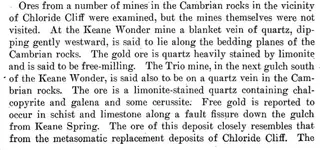
Keane Wonder mine was claimed in 1903 and produced over $1 million dollars. A piece of rich free-milling gold could have been
discovered by Breyfogle.
Note: One of the stories has Breyfogle escaping attack at Salt Spring or Resting Spring and
Traveling through Death Valley, finding the lode, and later found delirious near
Round Mountain, NV. That’s over 200 miles as the crow flies.

Breyfogle Points of Interest within and near, Death Valley
Note: The small dashed lines near the bottom of the map shows the trace of the Old Spanish Trail. Stump Spring, Resting Spring,
and Salt Spring are watering holes along the Old Spanish Trail. According to Harold O. Weight, Resting Spring was also known as Coyote Holes.
Note: Death Valley Buttes was also known as Breyfogle Buttes
Note: I believe the Furnace Creek referred to in the narratives is located near the headwater of Furnace Creek. Not the Furnace Creek that is presently
located in the valley of Death Valley.

The Keane Wonder mine and Chloride Cliff mine were rarely considered the origin of the Breyfogle discovery although the mines are located
in the Funeral Mountains, within the area Breyfogle conducted many of his searches.

Portion of page 174 from A Geologic Reconnaissance of the Southwestern Nevada and Eastern California, U.S.G.S. Bulletin 308, 1907.

Keane Wonder mine was claimed in 1903 and produced over $1 million dollars. A piece of rich free-milling gold could have been
discovered by Breyfogle.
KANACKI
Bronze Member
- Joined
- Mar 1, 2015
- Messages
- 1,445
- Reaction score
- 5,940
- Golden Thread
- 0
- Primary Interest:
- All Treasure Hunting
Hello aw11mr2
Some very interesting information and comments. However my apologizes in advance as I am like a snake that has gobbled up a large meal of information and need time to to sliver off and digest it.
To give a fitting reply to an excellent post.
Coffee?
Cheers Kanacki
Some very interesting information and comments. However my apologizes in advance as I am like a snake that has gobbled up a large meal of information and need time to to sliver off and digest it.

To give a fitting reply to an excellent post.
Coffee?
Cheers Kanacki
Oroblanco
Gold Member
- Joined
- Jan 21, 2005
- Messages
- 7,841
- Reaction score
- 9,876
- Golden Thread
- 0
- Location
- DAKOTA TERRITORY
- Detector(s) used
- Tesoro Lobo Supertraq, (95%) Garrett Scorpion (5%)
- #110
Thread Owner
Hello Oro
I do not know for sure if you might of met Hardluck or talked to him on another forum? He had a reasonable solution to such treasure stories is to search for the earliest account is more likely an more accurate version of such stories. His analogy of such stories the later stories are like branches growing off the original stump and take on a life of thier own.
Coffee?
Kanacki
I haven't met Hardluck in person but have talked with him online, and that is the same method I generally use in sorting out the source materials when we have so much of it. In this instance I am not 100 % certain it will work, because we do not know for certain if the earliest version(s) published came from the original Breyfogle that found the gold ledge in the first place, or from one of the other Breyfogles that went in search of it. For example we know of two Charles Breyfogles, both of which went to the area and the first one (Charles) returned home with a sizable fortune in gold, the second Charles (Charles C) did not return with a fortune in gold but did search for the ledge. Yet another one (Israel) returned home with a fortune in gold as well, and was with the 1849 party; one version of the tale has the finder as a member of a 49ers wagon train who discovered the vein while away from the train. This could have been Israel. And as the family history tells us, several Breyfogles were in the party of 49ers, and we know that Jacob learned of the gold from Charles and left his blacksmithing work to go to the desert to hunt for it. This suggests that it was the first Charles (not Charles C.) whom had been the original finder of the legend. I can't prove which Breyfogle was "the" original Breyfogle to find the vein of gold, but at this point my money is on the first Charles and the other Breyfogles were trying to find his site in later years.
I suspect that Jacob Breyfogle, as a blacksmith - is the Breyfogle that was a blacksmith in Austin and headed up several searches for the lost mine. Jacob was certainly not the first one to discover it however.
Side thing but a Henry Breyfogle is also named in one version, haven't been able to figure out where this fellow fits in the crazy quilt that is this tale. Anyone find any record(s) of a Henry Breyfogle living in Nevada or California? Thanks in advance.
Thanks for the info aw11mr2!




KANACKI
Bronze Member
- Joined
- Mar 1, 2015
- Messages
- 1,445
- Reaction score
- 5,940
- Golden Thread
- 0
- Primary Interest:
- All Treasure Hunting
Here is more on Charles C Breyfogle.
Charles C Breyfogle in the Salt Lake County, Index to Probate Case Files, 1852-81
Given Name: Charles
Middle Name: C
Surname: Breyfogle
Case Number: 0329
Date: 3 Jan 1873
Subject: Estate
Anyone able to get more data on his probate would be much much obliged.
Coffee?
Kanacki
Charles C Breyfogle in the Salt Lake County, Index to Probate Case Files, 1852-81
Given Name: Charles
Middle Name: C
Surname: Breyfogle
Case Number: 0329
Date: 3 Jan 1873
Subject: Estate
Anyone able to get more data on his probate would be much much obliged.
Coffee?
Kanacki
Oroblanco
Gold Member
- Joined
- Jan 21, 2005
- Messages
- 7,841
- Reaction score
- 9,876
- Golden Thread
- 0
- Location
- DAKOTA TERRITORY
- Detector(s) used
- Tesoro Lobo Supertraq, (95%) Garrett Scorpion (5%)
- #112
Thread Owner
Here is more on Charles C Breyfogle.
Charles C Breyfogle in the Salt Lake County, Index to Probate Case Files, 1852-81
Given Name: Charles
Middle Name: C
Surname: Breyfogle
Case Number: 0329
Date: 3 Jan 1873
Subject: Estate
Anyone able to get more data on his probate would be much much obliged.
Coffee?
Kanacki
Not the probate info but it is possible to follow the course of events from his being accused, the 'flight' and arrest, trail, sentence and then release on the numerous newspaper articles from the era. For anyone curious a good collection is at: https://cdnc.ucr.edu/
Be forewarned that the name Breyfogle gets mangled in spelling in those newspaper accounts, including but not limited to Bryfogle, Brifogle, Brefogle etc. However we now know from the family history that first 'e' is pronounced like a long I so maybe I can quit mispronouncing it after all.
Please do continue, and on the Henry B info unfortunately there are a number of them and I am trying to sort it out, if any of them were in the Death Valley country at all.




KANACKI
Bronze Member
- Joined
- Mar 1, 2015
- Messages
- 1,445
- Reaction score
- 5,940
- Golden Thread
- 0
- Primary Interest:
- All Treasure Hunting
My apologies for not posting replays to such interesting posts. I am doing so much at present my brain is bouncing around in my skull. My Son is picking me up in Bali for a sail. I am awaiting my new passport. As its in the process of renewal.
I be sailing again around Bali across the north coast of Java to Sumatra then back to Bali via the south coast of Java.

Once in Sumatra we are going to hike in the mountains.
Perhaps do a little diving along the way.
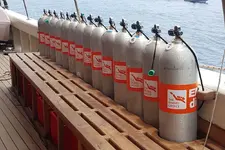
But rest assured doing in style.

Gotta keep the better half happy.
And no more cold beans and spam. Been there done that!
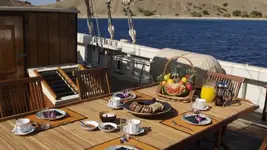
Kanacki
I be sailing again around Bali across the north coast of Java to Sumatra then back to Bali via the south coast of Java.

Once in Sumatra we are going to hike in the mountains.
Perhaps do a little diving along the way.

But rest assured doing in style.

Gotta keep the better half happy.
And no more cold beans and spam. Been there done that!

Kanacki
Last edited:
JohnWhite
Bronze Member
- Joined
- Aug 20, 2017
- Messages
- 1,546
- Reaction score
- 1,430
- Golden Thread
- 0
- Detector(s) used
- Whites gmt
- Primary Interest:
- All Treasure Hunting
My apologies for not posting replays to such interesting posts. I am doing so much at present my brain is bouncing around in my skull. My Son is picking me up in Bali for a sail. I am awaiting my new passport. As its in the process of renewal.
I be sailing again around Bali across the north coast of Java to Sumatra then back to Bali via the south coast of Java.
View attachment 1804228
Once in Sumatra we are going to hike in the mountains.
Perhaps do a little diving along the way.
View attachment 1804229
But rest assured doing in style.
View attachment 1804230
Gotta keep the better half happy.
And no more cold beans and spam. Been there done that!
View attachment 1804231
Kanacki
Dang Kanacki!!! It appears that your ship has come in...I wish you smooth sailing and calm seas...
I though am still quite content with spam and beans...lol...Maybe one of these darned days I will jump onto one of the ships that keeps on sailing by trying to get me to jump on board...Only time will tell...
Ed T
BillA
Bronze Member
Hola Kanacki
pics for us landlubbers eh
good trip
pics for us landlubbers eh
good trip
Oroblanco
Gold Member
- Joined
- Jan 21, 2005
- Messages
- 7,841
- Reaction score
- 9,876
- Golden Thread
- 0
- Location
- DAKOTA TERRITORY
- Detector(s) used
- Tesoro Lobo Supertraq, (95%) Garrett Scorpion (5%)
- #116
Thread Owner
My apologies for not posting replays to such interesting posts. I am doing so much at present my brain is bouncing around in my skull. My Son is picking me up in Bali for a sail. I am awaiting my new passport. As its in the process of renewal.
I be sailing again around Bali across the north coast of Java to Sumatra then back to Bali via the south coast of Java.
View attachment 1804228
Once in Sumatra we are going to hike in the mountains.
Perhaps do a little diving along the way.
View attachment 1804229
But rest assured doing in style.
View attachment 1804230
Gotta keep the better half happy.
And no more cold beans and spam. Been there done that!
View attachment 1804231
Kanacki
Good luck and good hunting amigo, I hope you find the treasures that you seek. And please come back and post photos to inspire us and make us drool!



Afterthought - no luck on the Henry B yet. Still looking though.
BillA
Bronze Member
Hi Kanacki, we await your update
Best, Bill
Best, Bill
Crow
Silver Member
- Joined
- Jan 28, 2005
- Messages
- 4,036
- Reaction score
- 11,236
- Golden Thread
- 0
- Location
- In a tax haven some where
- Detector(s) used
- ONES THAT GO BEEP! :-)
- Primary Interest:
- Other
Gidday Bill
I doubt ya going to hear from him for a while?
Because of this Corna Virus. In Indonesia each island governor with not let non essential vessels to land. So in effect Kanacki is stuck on his schooner. He cannot leave Indonesia because no nation with take him as his vessel is classed as a foreign flagged vessel. He cannot go back to Micronesia because they have totally closed borders to even its own citizens because they do not have the medical support to deal with corna virus. And it does not seem there is going to be a solution to virus anytime soon. And virus is spreading out of control throughout Indonesia. He has to stay away from villages as they might accuse him as a scapegoat for spreading the virus?
So having no port to go to he is hiding out in a remote uninhabited part of Indonesia.
Like any good pirate ever resourceful I knew where he is. Rest assured that old sea dog is making the best of it.
Cheers Crow
I doubt ya going to hear from him for a while?
Because of this Corna Virus. In Indonesia each island governor with not let non essential vessels to land. So in effect Kanacki is stuck on his schooner. He cannot leave Indonesia because no nation with take him as his vessel is classed as a foreign flagged vessel. He cannot go back to Micronesia because they have totally closed borders to even its own citizens because they do not have the medical support to deal with corna virus. And it does not seem there is going to be a solution to virus anytime soon. And virus is spreading out of control throughout Indonesia. He has to stay away from villages as they might accuse him as a scapegoat for spreading the virus?
So having no port to go to he is hiding out in a remote uninhabited part of Indonesia.
Like any good pirate ever resourceful I knew where he is. Rest assured that old sea dog is making the best of it.
Cheers Crow
BillA
Bronze Member
Thanks for the update Crow, potentially distressing but one does what's needed.
Gonna be a hellofatale.
Gonna be a hellofatale.
Crow
Silver Member
- Joined
- Jan 28, 2005
- Messages
- 4,036
- Reaction score
- 11,236
- Golden Thread
- 0
- Location
- In a tax haven some where
- Detector(s) used
- ONES THAT GO BEEP! :-)
- Primary Interest:
- Other
Gidday Bill
I have had the pleasure chatting of old Kanacki tonight. We had a project in Indonesia however corvid 19 has created problems there. We was hoping he could ride out the pandemic there but Many areas are shut to outsiders. While is could take months to resolve we decided to postpone that project until epidemic stabilizes. So Kanacki will head back to Micronesia. However he can only enter Micronesia via a country with little or no infection. So he can travel to Rabual in PNG await 2 weeks in his schooner in Quarantine. Then sail to a port of entry where he will be confined again for 2 weeks in his ship.
Ah such is winds of fate amigo!
Crow
I have had the pleasure chatting of old Kanacki tonight. We had a project in Indonesia however corvid 19 has created problems there. We was hoping he could ride out the pandemic there but Many areas are shut to outsiders. While is could take months to resolve we decided to postpone that project until epidemic stabilizes. So Kanacki will head back to Micronesia. However he can only enter Micronesia via a country with little or no infection. So he can travel to Rabual in PNG await 2 weeks in his schooner in Quarantine. Then sail to a port of entry where he will be confined again for 2 weeks in his ship.
Ah such is winds of fate amigo!
Crow
Similar threads
Users who are viewing this thread
Total: 1 (members: 0, guests: 1)



